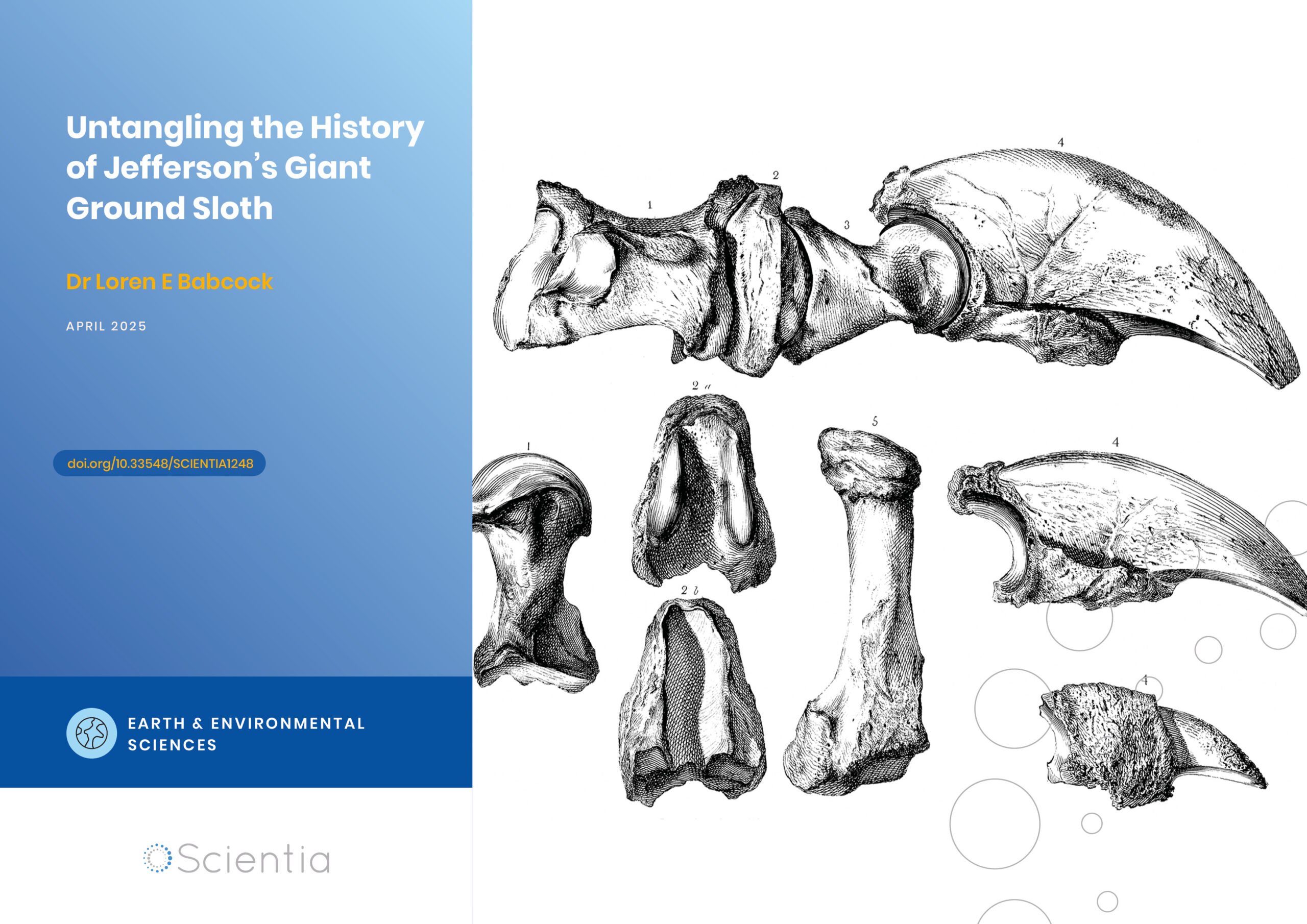Building Community Resiliency through Horticultural Innovation
Food insecurity directly impacts a third of the world’s population and perpetuates a cycle of hunger and malnutrition that is inherited through generations. Previous relief efforts have largely been donor-focused, providing only temporary solutions. To break the cycle of food insecurity, poverty, and hunger, relief efforts must empower communities and facilitate real transformative changes. Professor James Simon of Rutgers University and colleagues have developed a transferable horticulture model that builds upon local ecosystem knowledge and cultural infrastructures while embedding science-driven, market-first, and value chain methodologies. Introduced into several countries in sub-Saharan Africa, the model includes agribusiness and technical skills training to strengthen the participation of farmers and local entrepreneurs, particularly women and youth, in profitable value chains. Using this novel approach, the Rutgers team and their African colleagues have successfully demonstrated how horticulture can contribute to a real reduction in poverty and malnutrition, while fostering job creation, pride and creativity.
Vicious Cycle of Poverty and Malnutrition
At least 820 million people are hungry today. Tomorrow they will be hungry again, and again the day after that. The relentless daily hunger experienced by one in seven people worldwide is inextricably linked with poverty. Of the world’s 7 billion people, 37% live on less than $2 USD per day. Families already struggling to adequately feed and nourish themselves have little hope of gathering additional resources to break the cycle of poverty and hunger that is passed down through generations.
In 2010, the Food and Agriculture Organization estimated that of the 925 million malnourished people across the globe, 239 million (over one quarter) are from sub-Saharan Africa. According to the World Bank, the number of people living in poverty in the region increased from 278 million in 1990 to 413 million in 2015. Continued population growth and worsening agricultural productivity – owing to the pressures of climate change – are likely to further exacerbate poverty, hunger, and malnutrition.
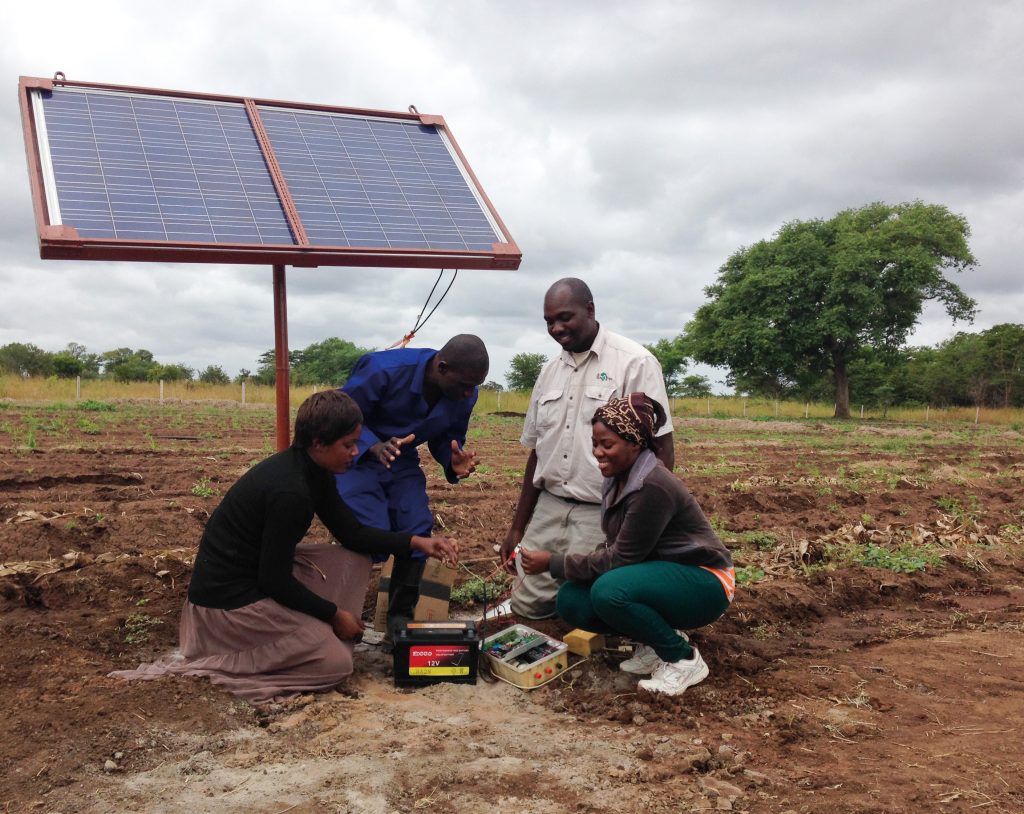
Growers greatly benefit from solar panels that power irrigation pumps and electric fences protecting crops from elephants and other animals.
The Need for Innovative, Community-Based Solutions
Tackling today’s complex food systems challenges must begin by understanding the social, cultural, and environmental infrastructure and local knowledge of the communities in need.
Prior to the Colonial disenfranchisement, indigenous communities throughout the world evolved complex agricultural practices that were uniquely suited to supporting populations and associated cultures within the limits of their local ecosystems. Historically, conventional food aid programs administered by industrialised countries with the intent of providing immediate help too often ignored local knowledge and traditional practices.
This top-down approach reduced hunger and malnutrition through the immediate provision of food and other relief, but often only temporarily. Without analysing a community’s complexity and addressing local obstacles preventing people from becoming self-sufficient and independent, communities remain locked in cycles of poverty that reduce their future resilience.
Significant international aid provides massive immediate relief, with staple crops providing the energy, protein, and carbohydrates to satiate large and vulnerable populations. However, the underlying issues that lead to crisis and the need for humanitarian relief are often not resolved or addressed.
Furthermore, the dependence on foreign crops and foreign agricultural methods may not always be appropriate for the climate and environment of sub-Saharan Africa. The intensive agricultural practices that would be required to produce some temperate-zone crops could, in some cases, make these food crops largely unsustainable and prohibitively costly, limiting their long-term efficacy.
Conventional foreign aid, while providing many benefits, may also come with negative social outcomes for many developing communities. Internalised oppression lingers from the days of colonial rule, the psychological effects of which include a negative view of traditional cultural practices such as indigenous agricultural and traditional foods and a lack of perceived value on native and indigenous plants, simply because they are not part of the larger-scale commercial agricultural industry. Integrating traditional agricultural knowledge into food system interventions and practices can inspire long-lasting positive behavioural changes.
‘One aspect of our project is working with communities to promote the historical legacy of the vegetables to increase demand across communities’ – Emily Merchant, Program Coordinator
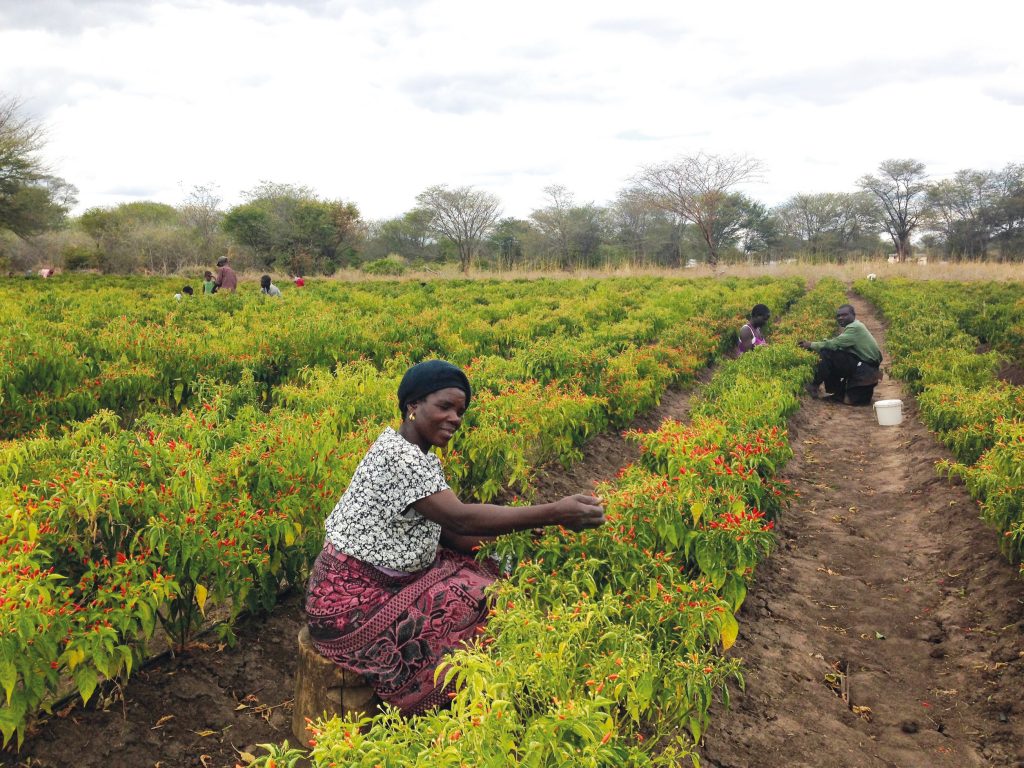
Growers harvest African Birds Eye Chili in southern Zambia where fruits are dried, graded, sorted and sold to local and regional markets.
Horticulture for a Better Future
The enormities of today’s food security challenges require innovative, sustainable, place-based solutions.
New nutritional and economic strategies that are sensitive to the unique, local knowledge, as well as the challenges facing developing communities across sub-Saharan Africa, are desperately needed. Long-term improvements require a holistic approach that tackles the root causes of poverty and malnutrition, while inspiring pride in local and sustainable agricultural practices. Recognising this major challenge, the United States Agency for International Development (USAID) produced an ambitious multi-sectoral strategy for 2014–2025 to decrease malnutrition, improve nutrition, and increase economic productivity.
Horticulture, focusing on the cultivation of local and indigenous fruits, vegetables, flowers, and medicinal crops, has the potential to form the basis for the ambitious nutritional and economic strategies that support USAID’s objectives. Since 70% of the world’s extreme poor live in rural areas, and most are farmers, strategies that focus on culturally based agri-business have the potential to capture many of the most vulnerable communities.
Horticultural crops are ideal for efforts to improve nutritional and economic outcomes. A diverse diet including at least 400 grams of fruits and vegetables daily can prevent malnutrition, due to their high vitamin and mineral content. Horticultural crops can provide these important micronutrients without excessive calories, mitigating the risk of hidden hunger. Preventing malnutrition during the early years of childhood supports development and lifelong optimal health, which can benefit and improve the resilience and wellbeing of communities for decades.
Through years of research and refinement, Professor James Simon and a team of researchers from Rutgers University in collaboration with African colleagues have developed a comprehensive model that is transforming the agricultural landscape for communities across sub-Saharan Africa. With horticulture at its core, their strategy focuses on identifying and building opportunities from the bottom-up, by empowering communities to take charge of their own social, cultural, environmental, and economic futures.
The team’s first focus was on African botanicals, which include under-utilised and under-recognised herbs, spices, nuts, plant-based butter, and medicinal plants. To some, these were mere ‘boutique crops’ and therefore not largely recognised by commercial enterprises; however, for the communities involved in collecting or growing and harvesting such plants, these crops demonstrated how under-utilised local plants could contribute to food security and improved nutrition.
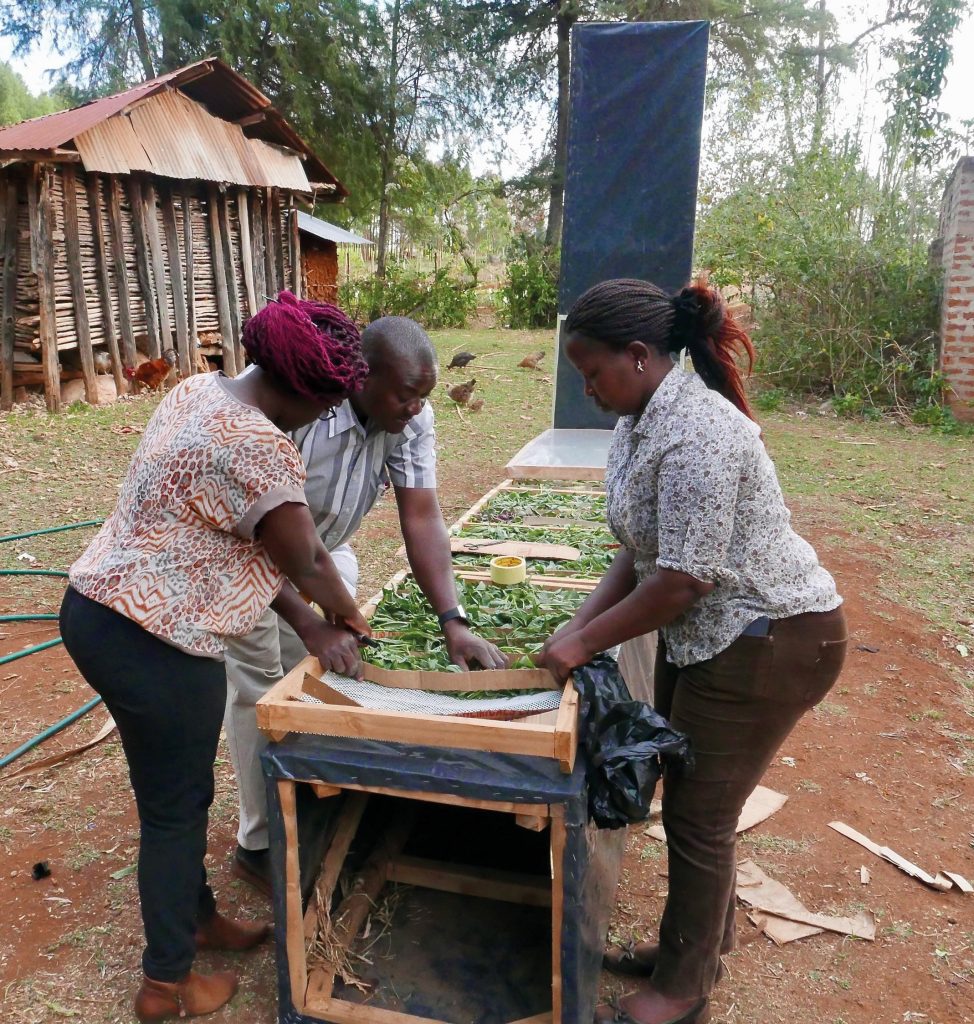
Agronomists drying African Indigenous Vegetables using a solar dryer. CREDIT: David Byrnes.
This iterative model began to incorporate a strong focus on indigenous horticultural crops, including African indigenous vegetables. These plants, which exhibit general climate change resiliency and are well suited to the growing conditions in sub-Saharan Africa, were identified by way of community surveys to be a preferred food choice, but were generally unavailable.
Traditional indigenous crops, as well as novel indigenous food plants, have amazing potential to combat malnutrition while generating jobs and income. Scientific evaluations have already demonstrated many health and nutritional benefits that these plants can provide, including high antioxidant capabilities, and excellent phytochemical and bioactive profiles.
Such foods have great market potential from local to regional and international levels. Building success with indigenous horticultural crops can improve social outcomes by fostering a sense of cultural pride and belonging. A focus on these indigenous crops can contribute significantly to overcoming hunger and improving nutrition, and create income generation opportunities for women and youth.
Horticultural strategies have the potential to target some of the most marginalised groups. Many of the individuals included in the team’s projects in sub-Saharan Africa are women, single-parent families and the elderly, as well as populations that are re-building after war and other crises. Empowering previously marginalised groups benefits not only those individuals but also stimulates the local economy, thus benefiting the entire community.
Importantly, families do not stop cultivating traditional staple or commodity crops to begin cultivating horticultural crops. Rather, the higher-value crops are introduced and promoted as additional crop enterprises, and are not intended to replace the families’ and communities’ core staple crops. Farming small plots, such as gardens, is possible alongside traditional crops. This can significantly improve food security, because year-round production is possible with adequate watering. Daily water collections from natural waterways can eventually be replaced with gravity-controlled irrigation systems, water collection systems and others that are simple and easy to install.
Horticulture can be a particularly lucrative endeavour; in comparison to traditional commodity crops, horticultural fruits and vegetables obtain a higher price. The additional income from selling high-value horticultural crops can help support improvements in infrastructure and education. Freed from the daily struggle of survival, communities of well-nourished, healthy people with some money to spare can begin focusing on building a better future for themselves.
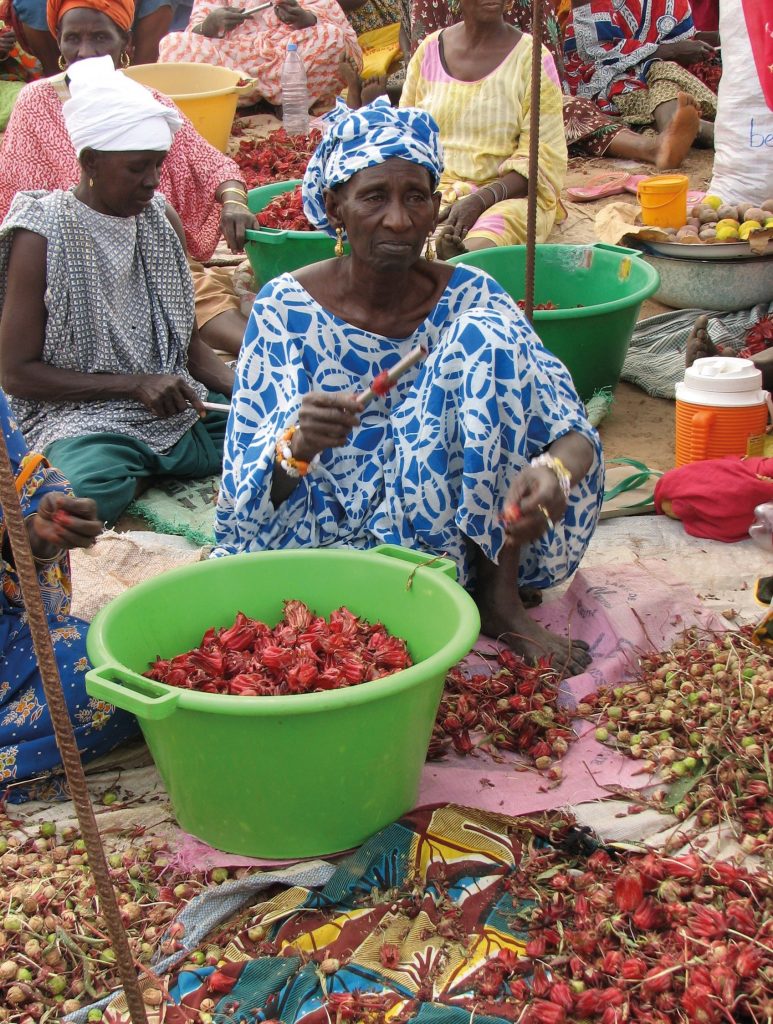
Women using a tool to more efficiently and quickly remove the seeds from hibiscus (Hibiscus sabdariffa) calyx in order to prepare them for market. CREDIT: Rodolfo Juliani.
Community-Based Science and Market-Driven Approach
Professor Simon’s model takes a three-pronged systems approach to a complex problem, beginning by building upon indigenous agricultural practices, reinforced by science and new technologies, and sustainably developed for the market to ensure economic resilience. The model focuses on ‘the four As’: Access, Availability, Affordability and Adoption of all the crops targeted in consumer and market demand.
Rather than using a production-based approach, the team uses a market-first paradigm, which from the outset, identifies local community champions and leaders from the private and public sector that can form strategic partnerships with communities. These local leaders are included at the onset so that they actively participate in shaping their horticultural enterprises and develop their technical and leadership skills to sustain the food system long after the project ends.
The team’s Community-Based Science and Market-Driven approach completely overhauls outdated relief strategies to effectively release communities from the cycle of dependence, poverty, hunger, and malnutrition, by focusing on developing new culturally and locally-based agri-businesses, or strengthening existing ones. While previous approaches often focused on a single area or commodity, the team’s holistic strategy begins with local knowledge and capacity building, incorporating market research, supply-chain development, scientific evidence, sustainable improvements to cultivation, and value-adding activities.
The projects begin from the bottom-up, by first generating local demand and fostering partnerships, providing farmers with the opportunity to learn new skills and then scaling up production at a manageable pace. Entrepreneurship training then provides farmers with skills to manage their horticultural enterprises. These transferable skills empower local individuals to form new businesses and agricultural opportunities, while training new members of their community beyond the scope of the project.
Throughout the process, Professor Simon and his colleagues support farmers with value-added technologies, such as tools to increase processing efficiency. Supported by thorough market research and the technical support of the team, farmers can then organically expand their businesses to reach regional, national, and international markets. This market-driven strategy ensures that all of the communities involved can successfully develop thriving horticultural enterprises.
‘By valorising their enormous contributions, this model ultimately sought to empower women by helping them access and manage their resources and making them true stakeholders in the development of their communities. These farmers have responded by taking full advantage of the package of services to improve the quality of their production, harvest, and post-harvest treatment of hibiscus’ – Dan Acquaye, Founder of ASNAPP-Ghana
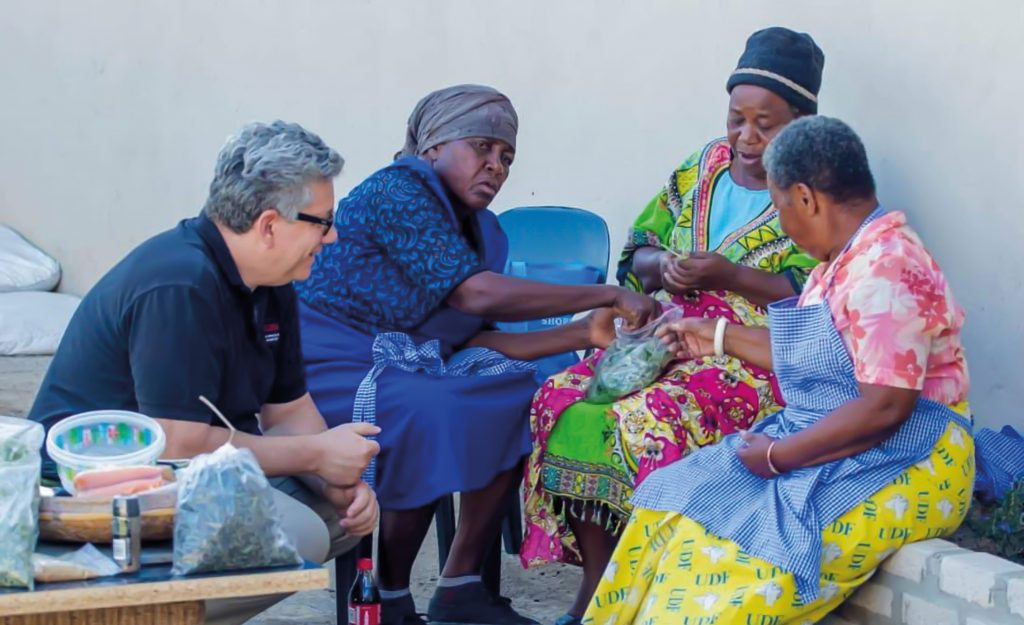
Women participating in a community cooking day featuring African Indigenous Vegetables. CREDIT: Nthano photography.
Demonstrating the culinary potential of African indigenous vegetables proved to be a successful strategy to engage consumers. This was done to eliminate the prior stigma associated with local plants that, while known to be nutritious, had been termed ‘famine foods’. ‘This perception is a barrier for farmers attempting to sell their crops in formal market places such as grocery stores, restaurants, and hotels,’ says Emily Merchant, Program Coordinator, and a PhD candidate. ‘One aspect of our project is working with communities to promote the historical legacy of the vegetables to increase demand across communities.’
Seeing – and tasting – the results convinced many uncertain consumers. Cultivating indigenous produce keeps the focus on the local community and culture, and helps to increase the pride and motivation of project participants. Additionally, indigenous plants work with the regional landscape and environment, ensuring future climate resilience.
The safety and nutritional analyses of indigenous crops have helped to drive international demand for some of these food plants. For example, the anti-diabetic properties of ‘kinkéliba’, the Senegalese bush tea, first discovered and reported by Professor Simon and his colleague, Dr Qing-Li Wu, gathered international interest, stimulating a market for kinkéliba, which is now used in foods and cosmetics. Rutgers University’s progressive policy also ensures that any technologies licensed, such as for medicinal use, must provide fair benefits back to the source country.
This multi-faceted approach tackles the unique barriers to horticultural enterprise faced by communities in developing countries. For example, in many regions targeted by the projects, high-quality seed systems were not in place for horticultural crops. Previous efforts to implement horticultural systems have been limited by a lack of investment in capital and materials. Unable to access agricultural credit, communities could not afford the high transaction costs and high risks involved with setting up horticultural systems. By setting up reliable, high-quality seed systems, the project team established sustainable supplies. Additionally, micro-grants awarded to farmers and communities as part of the projects incentivised innovation, entrepreneurship, and independence.
The team has applied their model to multiple communities – using regionally appropriate horticultural crops – across sub-Saharan Africa, including Zambia, Kenya, Tanzania, Senegal, Rwanda, Ghana, and Liberia. The success of these projects across multiple communities and crops demonstrates the adaptability and transferability of the model.
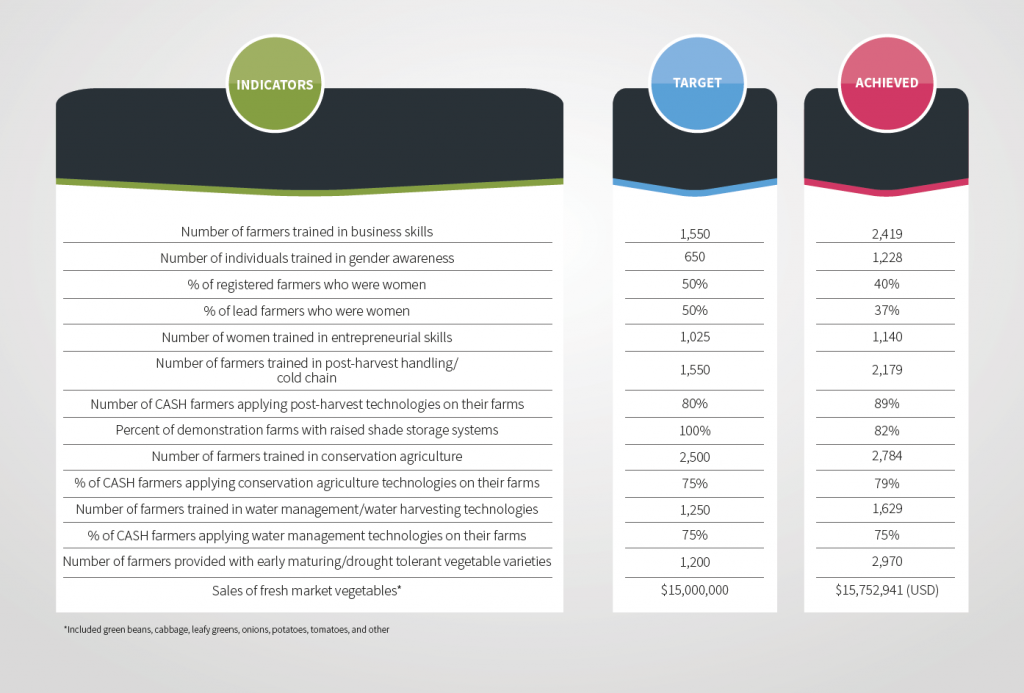
Table 1: An example of the economic impact of one of the team’s projects relative to commercialisation of fresh market vegetables in Zambia, with farmers who had not been involved in commercial horticulture, conducted under the CASH project in Years 3 and 4 (in which production and sales began)
Case Study: Senegalese Hibiscus (Bissap)
Communities in rural Senegal, and particularly women, face many challenges that prevent sustainable rural development. Women in these villages tend to grow peanuts and other low-value crops that generate insufficient income to support their families. Without access to accurate market information, they are more likely to undervalue their product. Senegalese women are often marginalised in rural affairs and have poor access to land and resources.
Professor Simon and the team from Rutgers University collaborated with their core African partner, Agribusiness in Sustainable Natural African Plant Products (ASNAPP) in Senegal and Ghana, to form horticultural cooperatives in rural villages, reaching over 35 grower groups. ‘By valorising their enormous contributions, this model ultimately sought to empower women by helping them access and manage their resources and making them true stakeholders in the development of their communities,’ says Dan Acquaye, Founder of ASNAPP-Ghana. ‘These farmers have responded by taking full advantage of the package of services to improve the quality of their production, harvest, and post-harvest treatment of hibiscus.’
Hibiscus is cultivated for the edible, fruit-like ‘calyces’ that form after blooming. With multiple uses including tea, cold drinks, and beauty products, hibiscus is a promising plant for horticultural development. However, before the intervention, it was largely neglected with low yields that only secured around $1 USD per kilogram.
ASNAPP together with Professor Simon’s team facilitated and mentored farmer-owned horticultural start-ups by introducing good agricultural practices, improved seeds, and seeding technology that reduced planting time from 14 days to two days per hectare, saving farmers $90 USD per hectare. Through this program, the team trained over 4000 women in hibiscus cultivation and entrepreneurship, including local champions that acted as the link between the cooperatives and buyers.
By identifying the labour-intensive tasks and implementing timesaving tools, the team was able to dramatically improve the volume of produce that the groups could process. One example is the labour and time involved in processing hibiscus calyces individually prior to drying. To ensure production could be scaled up, a simple device identified in Southeast Asia was introduced to process multiple calyces at once. This ensured the groups were able to keep up as yields improved through better agricultural practices.
‘In addition, implementing a robust quality assurance and control systems increases the value of the Senegalese hibiscus,’ says team member Dr Rodolfo Juliani. ‘The demand increased for this product due to its superior quality, leading to more marketing opportunities and higher prices for the Senegalese women growers. These systems also allow traceability from farm to table.’
Along with other value-added efforts, such as organic certification for 350 hectares of farmland, these techniques have facilitated expansion to national and international markets. The price obtained for hibiscus has more than doubled after the team’s intervention strategies. Farmers sometimes argued that they could not add value to their produce; however, generating high-quality raw botanical ingredients is a cost-effective way of adding value. These quality assurance systems were transferred to local researchers, so that they were able to conduct simple quality testing in locally built laboratories.
The secure income generated from their horticultural enterprises has allowed these Senegalese groups the freedom to contribute to the development of their communities. ‘The women have demonstrated their commitment to local development focused on the health and education of their children, food security, environmental sustainability, and community vitality,’ says Professor Simon. Today, hibiscus is now a national crop of Senegal with significant market potential.
‘After all these years of being engaged in international development, seeing successes and realising that some of our initial efforts fell short, we came to recognise how fortunate and blessed we are to have worked with so many people in so many countries and stayed focused on empowering the lives of others using horticulture and natural products’ – Professor Simon
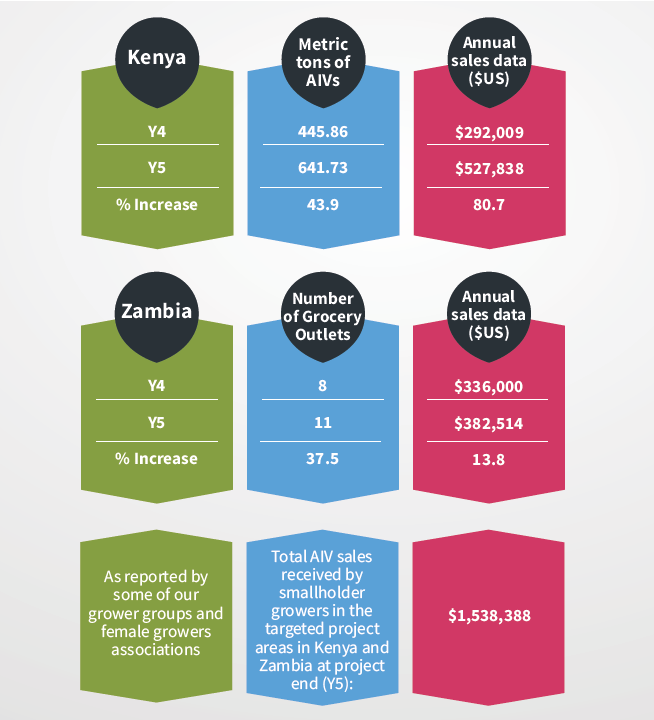
Table 2: Sales of African Indigenous Vegetables in Kenya and Zambia under the AIV project in the Horticulture Innovation Lab between October 2017 and October 2018, and between October 2018 and October 2019 (Years 4 and 5 of the project, in which production and sales began)
Transferability is Key
The team’s community and science-based market-first model for horticultural development, known as Food-systems for Empowerment, Economic Development and Sustainability (FEEDS), has produced transformative changes across multiple regions and communities.
Applied throughout the sub-Saharan Africa cities of Lusaka and Chipata in Zambia and Eldoret in Kenya, FEEDS was found to be highly adaptable and demonstrated success in fostering alliances along the food system value-chain, promoting science-driven impact and policy change, adding value to community and government initiatives and building capacity for farmers and distributors, in addition to empowering the community voice. Ultimately, the FEEDS projects provided long-lasting climate-smart infrastructure change and led to millions of dollars of income generation by local growers, distributors and suppliers who are now independently operating.
One significant FEEDS project, the USAID-funded Commercial Agriculture and Sustainable Horticulture (CASH) in Lusaka, Zambia, included partnerships with 71 farmer groups and was designed to improve their production, expand their growing seasons, and collectively market their produce. The project reached nearly 2500 farmers, around 40% of them women, providing agricultural and entrepreneurship training.
Ultimately, in the last three years of a four-year project, the groups generated over $11 million USD in sales of fresh produce. This success was due to the motivation and dedication of growers and communities selected, the intensive training provided, the focus on quality control, the use of a science-driven and market-first approach and preparation of crops for the market. The farmers had become disciplined and efficient in scheduling, selecting varieties, grading, sorting and packaging to meet buyers’ needs and market requirements, including food safety.
In another project, the team introduced African indigenous vegetables to over 1,000 farmers that had never grown these crops before. After two years, sales of these crops exceeded $500,000 USD annually. One component of that study, funded by the Horticulture Innovation Lab with USAID-funds, showed that farmers growing African indigenous vegetables consumed more of these crops themselves. That study also showed that people growing indigenous vegetables using sack gardens or other technologies in urban areas were more excited about consuming these crops when products were available, accessible and affordable.

The team’s projects have reached some of Africa’s most vulnerable individuals and communities. A FEEDS project in Rwanda focused on re-establishing the essential oil industry, in collaboration with World Relief, a local community-interest business called Ikirezi Natural Products, and two women’s associations. The project reached over 500 people, including widows, young women and orphans impacted by the Rwandan genocide. The outcome was organically certified essential oil of geranium sold on the international market, with profits returned to communities for empowerment and reinvestment.
Key elements that allow this model to be scaled or transferable include: strengthening and empowering local champions; community engagement; building trust and confidence; ensuring real markets for crops and botanicals are available; meeting community, government and funder expectations; and providing practical solutions with human capacity building, skills training, and the introduction of new technologies and processes.
The team is now applying their successful development model to communities outside sub-Saharan Africa. ‘Our new programs are designed with Rutgers University’s Institute for Food, Nutrition and Health’s Center for Agricultural Food Ecosystems to transfer and apply the “Community-Based Science, Market-First Sustainable Horticulture for Urban Food Security” model to the diverse and economically challenged and food insecure communities in the US struggling in a COVID-19 environment,’ says Professor Simon.
‘We all continue to change and learn from each other and our community partners. After all these years of being engaged in international development, seeing successes and realising that some of our initial efforts fell short, we came to recognise how fortunate and blessed we are to have worked with so many people in so many countries and stayed focused on empowering the lives of others using horticulture and natural products in the broadest sense – herbs, spices, botanicals, indigenous fruits and vegetables,’ he adds.
‘As it’s working, we now have a responsibility to build upon knowledge gained and lessons learned to help others build community-based resilience against poverty and malnutrition. Our global ideas for addressing food systems and food insecurity have been built over time from our original market-first science-driven model to the demonstrated work and success of our resilient, food systems for empowerment, economic development and sustainability model in sub-Saharan Africa.’
‘These initiatives have tested the merging of science, theory and practical solutions, while respecting national and local governments and the embedded cultural norms of tribal and ethnic groups in which we have been honoured to be invited to work’ – Professor Simon.

Women selling African Indigenous Vegetables at the market.
Ingredients for Success
Professor Simon believes that the team’s success has been largely due to the members’ creativity and diversity, their commitment to facilitate change for the benefit of the communities, their recognition that real economic improvement that changes the lives of individuals and communities creates motivation and incentive, and the local champions in the community that bring it together and make it happen.
Having a real commercial economic focus, coupled with an emphasis on developing strong technical skills in building, repairing and farming, allowed the projects to achieve significant economic improvements, while adhering to a community-led approach that prioritised economic, environmental and cultural sustainability.
‘These initiatives have tested the merging of science, theory and practical solutions, while respecting national and local governments and the embedded cultural norms of tribal and ethnic groups in which we have been honoured to be invited to work,’ says Professor Simon. ‘The 20+ year long-term partnership with ASNAPP-Ghana in particular has really helped transform the models developed.’
‘The strong public and private sector partnerships, and the trust that was developed among diverse stakeholders paved the way for overcoming many of the stumbling blocks that face international development projects,’ he adds. ‘Developing a shared vision in providing solutions to local hunger, lack of employment opportunities and viewing each of our stakeholders and partners with respect allowed us to use horticulture and indigenous plants as the economic driver in particular for women and youth.’
As a global community, we need to change. The global issue of poverty, malnutrition, and hunger requires proven solutions. The increasing pressures from climate change and environmental degradation demand these solutions are sustainable.
The continued and repeated successes of Professor Simon and his team’s agri-business model demonstrates that transformative, sustainable change is possible, and that the strategic inclusion of horticultural crops and indigenous foods and botanicals can provide economic, cultural and environmental sustainability and make a difference in increasing food security by improving the health, nutrition and income opportunities of so many. This model method has the power to fuel an agricultural revolution for a better future for all, and it’s ready to be replicated and scaled.
Reference
https://doi.org/10.33548/SCIENTIA601
Meet the researchers

CONTACT
W: http://newuseag.rutgers.edu
W: https://rucafe.rutgers.edu/
FUNDING
MCA-Namibia
US Foreign Agricultural Service
United States Department of Agriculture (USDA)
USDA – National Institute of Food and Agriculture
The New Jersey Agricultural Experiment Station
United States Agency for International Development (USAID)
ACKNOWLEDGEMENTS
The team wishes to thank the USDA and the US Agency for International Development (USAID) for their funding and support since 2000 under the many-awarded projects from ATRIP to ASNAPP to Partnerships in Food Industry Development for Natural Products and African Indigenous Vegetables (AIVs). The most recent includes the research supported partially by the Horticulture Innovation Lab with funding from USAID (EPA-A-00-09-00004), as part of the US Government’s global hunger and food security initiative, Feed the Future, for ‘Improving nutrition with AIVs’ in eastern Africa and prior USAID initiative including Partnership in Food Industry Development for Natural Products. The team also thanks the US State Department, Oxfam International, the New Jersey Agriculture Experiment Station (HATCH projects 12131 and NJ12158), Rutgers IFNH – New Jersey Institute for Food, Nutrition and Health, The Rutgers Center for Food Agricultural Ecosystems (RUCAFE), Academic Model Providing Access to Health Care (AMPATH), Mirror of Hope CBO, IKirezi, the World Vegetable Center (WorldVeg), Kenyan Agricultural and Livestock Organization (KALRO) and Agribusiness in Sustainable Natural African Plant Products (ASNAPP), World Relief, The Association de Sante, University of Cheikh Anta Diop, Dakar, Stellenbosch University and the University of California- Davis. They give special recognition to the following individuals for their support and encouragement: Jerry Brown, Carol Wilson, John Bowman, Beth Mitcham, Kelly Bauer Bennett, Elton Jefthas, Leopold Van Huyssteen, Soji Adelaja, Magette Wade, Bill Hallman, Brian Schilling, Xenia K. Morin, Mark Robson, Fekadu Dinssa, Norah Maiyo, Naman Nyabinda, Mebelo Mataa, John Shindano, Himoonga Bernard Moonga, Christine Ndinya, Martins Odendo, Elke Couch, Sandy Turketti, Craig Fulton, Andries Arendse, Lupiya Sakala, Evaristo Nyeleti, Nickson Mwale, Inonge Siziya, Geoffrey Silungwe, Samuel Mainga, Christabel Kabole, David R. Byrnes, William Reichert, Mwangala Mbeweu, Bo Yuan, Kenneth Chali, Larry Hwang, Justus R. Ochieng, Victor Afari-Sefa, Albert Ayeni, Emmanuel Bassene, Charles Quansah, Richard Akromah, M.L.K. Mensah, Rob McCaleb, Mark Blumenthal, and Thomas Nyawir.
FURTHER READING
JE Simon et al., Improving Income and Nutrition of Smallholder Farmers in Eastern Africa using a Market-First Science-Driven Approach to Enhance Value Chain Pro-duction of African Indigenous Vegetables, Journal of Medicinally Active Plants, 2020, 9, 289.
D Hoffman et al., Preventing micronutrient deficiencies using African Indigenous Vegetables in Kenya and Zambia, Sight and Life, 2018, 32, 177.
SC Weller et al., Sustainable production for more resilient food production systems: case study of African Indigenous Vegetables in Eastern Africa, Acta Horticulturae, 2015, 1102, 289.
R Govindasamy et al., Postharvest handling, processing, value, and marketing of African indigenous vegetables: A case study from Zambia, Journal of Medicinally Active Plants, 2020, 9, 209.
R Govindasamy et al., An assessment of African Indigenous Vegetables grower’s production practices and the environment: a case study from Zambia, Journal of Medicinally Active Plants, 2020, 9, 195.
DR Byrnes et al., Elemental micronutrient content and horticultural performance of various vegetable Amaranth genotypes, Journal of the American Society for Horticultural Science, 2017, 142, 265.
F Dinssa et al., Performances of vegetable Amaranth entries in yield and nutrient contents in Tanzania and Kenya and variety release, Journal of Medicinally Active Plants, 2020, 9, 181.
C Ndinya et al., Assessment of Seed Quality of Selected African Leafy Vegetables Produced in Western Kenya using Informal and Semi-formal Seed systems, Journal of Medicinally Active Plants, 2020, 9, 269.
L Brindisi et al., Comparative nutritional analysis between African Indigenous Vege-tables grown by urban farmers and those available for purchase in Kibera, Nairobi, Kenya: A Case Study, Journal of Medicinally Active Plants, 2020, 9, 166.
HR Juliani et al., Chemistry and quality of hibiscus (Hibiscus sabdariffa) for developing the natural product industry in Senegal, Journal of Food Science, 2009, 74, S113.
Want to republish our articles?
We encourage all formats of sharing and republishing of our articles. Whether you want to host on your website, publication or blog, we welcome this. Find out more
Creative Commons Licence
(CC BY 4.0)
This work is licensed under a Creative Commons Attribution 4.0 International License. 
What does this mean?
Share: You can copy and redistribute the material in any medium or format
Adapt: You can change, and build upon the material for any purpose, even commercially.
Credit: You must give appropriate credit, provide a link to the license, and indicate if changes were made.
More articles you may like
Calculating Steering Friction: Essential Engineering for Military Aircraft Safety
The safe operation of military training aircraft depends on precise engineering calculations that most of us never consider. Dr Bogdan Adrian Nicolin and Dr Ilie Nicolin from the National Institute for Aerospace Research in Romania have developed sophisticated methods to calculate the steering friction moment in military aircraft. This critical engineering parameter ensures that pilots can safely control aircraft during taxiing, take-off, and landing – making their work essential for both pilot training and flight safety.
Professor Robert B Heimann | Culinary Craftmanship: The Evolution of Pottery for Cooking
Cooking food is arguably one of the most important transitions in human evolution, and initiated hundreds of thousands of years of refinement in both technique and technology. Professor Emeritus Robert B Heimann of TU Bergakademie Freiberg, Germany, recently reviewed the evidence for early cooking vessels and tracks the evolution of their production, identifying important strategies of optimisation using various natural materials, firing methods, and designs to improve durability, functionality, and efficiency over time.
Dr Loren Babcock | Untangling the History of Jefferson’s Giant Ground Sloth
In the spring of 1796, workers mining saltpetre in a western Virginia cave unearthed several unusual bones. This would launch the scientific study of extinct animals in North America and connect one of America’s founding fathers to the early development of palaeontology. Some of these mysterious bones eventually made their way to future US President Thomas Jefferson at his Monticello estate. Dr Loren Babcock from The Ohio State University’s School of Earth Sciences has conducted an extensive review of the complex naming history of this iconic extinct animal. His research untangles over 200 years of inconsistent scientific terminology and establishes the definitive nomenclatural history of what would become known as Megalonyx jeffersonii.
Epigenetic Mysteries Unravelled: The Zinc-Finger Proteins
Exploring the complex mechanisms of cell development processes and DNA structure is critical to understanding how certain diseases, such as cancer, can arise. Professor Danny Reinberg and Dr Havva Ortabozkoyun from the University of Miami in Florida, USA, work to reveal the epigenetic mechanisms at play during cell division and development and, in turn, disease processes. Together, they are discovering new protein molecules involved in genome organisation, deepening our understanding of how cancers and other related conditions can develop.



